Great War (Pacifica): Difference between revisions
Tag: 2017 source edit |
Tag: 2017 source edit |
||
| Line 122: | Line 122: | ||
====Defence of Corinia (1949-1950)==== | ====Defence of Corinia (1949-1950)==== | ||
[[File:Ryuk Dae-Jung.jpg|thumb|Commodore {{Pacifica|Ryuk Dae-Jung}} in {{Pacifica|List of Stoinian cities|Carao}} | [[File:Ryuk Dae-Jung.jpg|thumb|Commodore {{Pacifica|Ryuk Dae-Jung}} in {{Pacifica|List of Stoinian cities|Carao}} before his inauguration as Lord Admiral of Corinia in 1949.]] | ||
At the outbreak of the war, the Stoinian Corinian Defence Fleet was largely ordered to maintain a defensive position in Corinia while troops could be mobilised overseas following the demobilisation of {{Pacifica|Ezervulge}}. On October 17th however, {{Pacifica|Stoinia|Corinia}} would see its first conflict, ending the one month of waiting. The Imperialist fleet lead by {{Pacifica|Karnetvor|Karnetvorian}} Admiral {{Pacifica|Vojkan Karanović}} consisted of roughly 42 and 31 {{Pacifica|Karnetvor|Karnetvorian}} and {{Pacifica|Techganet|Techanarean}} ships respectively. The joint task force was meant to cripple the Corinian Defence Fleet in a swift stroke. It would come face-to-face with multiple contingents of 65 ships of the Corinian Defence Fleet patrolling near the island of Taiping that belong to {{Pacifica|Stoinia}}. What ensued of the {{Pacifica|Battle of Taiping}} was a major Stoinian defeat as the sparse patrol detachment were picketted one by one and swiftly outgunned by the Imperialist fleet. Mainly Stoinian screen ships were sunk, but ship losses included 10 cruisers, the battlecruisers HMS ''Milescu'' and HMS ''Reghea'', and the battleship HMS ''Cetus''. In total, the Stoinians had lost 52 ships with the Imperialists only lost 13 ships. | At the outbreak of the war, the Stoinian Corinian Defence Fleet was largely ordered to maintain a defensive position in Corinia while troops could be mobilised overseas following the demobilisation of {{Pacifica|Ezervulge}}. On October 17th however, {{Pacifica|Stoinia|Corinia}} would see its first conflict, ending the one month of waiting. The Imperialist fleet lead by {{Pacifica|Karnetvor|Karnetvorian}} Admiral {{Pacifica|Vojkan Karanović}} consisted of roughly 42 and 31 {{Pacifica|Karnetvor|Karnetvorian}} and {{Pacifica|Techganet|Techanarean}} ships respectively. The joint task force was meant to cripple the Corinian Defence Fleet in a swift stroke. It would come face-to-face with multiple contingents of 65 ships of the Corinian Defence Fleet patrolling near the island of Taiping that belong to {{Pacifica|Stoinia}}. What ensued of the {{Pacifica|Battle of Taiping}} was a major Stoinian defeat as the sparse patrol detachment were picketted one by one and swiftly outgunned by the Imperialist fleet. Mainly Stoinian screen ships were sunk, but ship losses included 10 cruisers, the battlecruisers HMS ''Milescu'' and HMS ''Reghea'', and the battleship HMS ''Cetus''. In total, the Stoinians had lost 52 ships with the Imperialists only lost 13 ships. | ||
Revision as of 05:59, 30 July 2023
| Great War | |||||||
|---|---|---|---|---|---|---|---|
| |||||||
| Participants | |||||||
| Allies | Imperialists | ||||||
| Commanders and leaders | |||||||
Main Allied leaders:
|
Main Imperialist leaders:
| ||||||
| Casualties and losses | |||||||
The Great War was a series of interconnected wars and spin-off wars in the South Pacific that lasted from 1949 to 1955. It involved two opposing alliances: the Allies and the Imperialists and their respective allies. The major participants engaged their entire economic, industrial, and scientific capabilities in the war effort. It was the deadliest conflict in human history with over xx military and civilian casualties.
The Great War began on 27 August 1949 when Karnetvor under Stjepan Masić invaded the TCC from Tasternine. Subsequently, Sedunn, Ryccia and Stoina - dubbed the Allies, including the TCC - declared war on Karnetvor. Tekarai honoured its alliance with Karnetvor, and were collectively called the Imperialists.
Background
Sub-Capricorn
In the 1940s the political situation in the southern half of the South Pacific Ocean (i.e. the Sub-Capricorn) had been relatively stable since the collapse of the expansionist Karnetvorian Confederacy in 1928, which had been replaced by a unitary parliamentary constitutional monarchy. However, the Kingdom of Karnetvor was becoming overpopulated and the new welfare system struggled. In 1944 Stjepan Masić of the Social-Democratic Party was elected on a platform of social reforms, an expanded welfare system and a revanchist foreign policy. To solve Karnetvor's problems, he argued for securing control over the southern half of the South Pacific Ocean to provide the necessary goods and raw materials to his population and land for repopulation.
On 24 October 1944, Karnetvor and Tekarai signed a non-aggression pact. Tekarai was a colonial empire and had recently annexed Ubesii on the southeastern shores of the Mediterranean Sea, where Tekarai wished to expand further.
The Tasternine Archipelago was a main hub for trans-Pacific trade as well as for Karnetvorian power projection in the region. It was considered to be in a vulnerable position due to its proximity to Termina, located to its south. Since the Karnetvorian Confederacy had annexed Tasternine there had been calls to control the Terminan city states (TCC) along the Crabrian coast, and several proposals had been made to the TCC to let Karnetvor rent ports and build bases there, which had all been turned down, but not unanimously. Some city states favoured Karnetvorian control for the business opportunities it provided. Karnetvorian authorities sought to exploit the divide. By 1949, tensions were high.
On 23 August 1949, the Karnetvorian crown prince and his wife travelled to Clocktown, Termina, for trade negotiations. During a tour of the city, an immigrant called Alexandro Petro got on top of the car's hood and shot the Crown Prince in the chest three times before moving onto his wife, which he also shot three times, killing the couple. Petro was apprehended and taken to a prison where he would be executed. The TCC chancellor sincerely apologised for the murder. The following day, Karnetvor started mobilising in secret.
Supra-Capricorn
Similar to the Sup-Capricorn, the sub-equatorial region above the tropic of Capricorn colloquially also known as the middle of the South Pacific Ocean, saw the rise of political turmoil as well. In northeastern Cordilia, the Father States took control over the Ikaranarean states and Pastrala in 1880. Upset about the failures of the Triangular Empire, they had overthrown the governments of Ikarn, Narus and Ranaras, forcing the royals to flee to Reizen in the Frost Empire. In the Father States, expansionism was a means of acquiring new populations to increase production. Eventually, the Father States would be able to lift the burden of production off of the Indavral populations and instead on to other populations. Indavra was already rich in resources, but the labor of production could be pushed onto less resource rich areas. However, their first course of action was to "Restore their natural borders." This culminated in the annexation of Constadia (Tarnese: Constadea) and Tzardas (Tarnese: Țardaș), two Stoinian exclaves in 1932 and a full scale invasion of Losavra in 1945, leading to the capitulation and annexation of the country of more than 100 million in just 2 weeks. In 19XX, they signed a nonaggression pact with the Frankists and started militarizing more and more, building up all branches of the military for what they assumed would be a major war as they prepared for an invasion of Cadíæ following its civil war and Nea-gy.
Stegăroian Deterrence
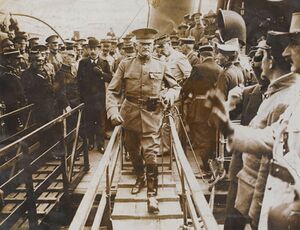
The Kingdom of Stoinia, saw a period of rapid military modernisation between the 1930s & 1940s under General Andrei Stegăroiu who was appointed Chief of Staff of the Defence Staff in late 1932. The modernisation was motivated in large part because of heightened tensions with neighbouring states following the Marsh Wars with Ezervulge and annexation of Constadea and Țardaș by the Father States following skirmishes in 1932. Stoinia under the King Mihai III saw the centralisation of leadership in both King and Prime Minister with the appointment of General Andrei Stegăroiu in 1941 as Prime Minister. Prioritising a deterrent foreign policy under military expertise, a renewed focus was given to the protection of Stoinian overseas territories in Cordilia and the Central Islands. Furthermore, the overseas ground forces saw modernisation up to the standard on Metropolitan Stoinia. This policy was intended as a deterrent to neighbouring nations who might have dreams of claiming Stoinian overseas territories as their own.
This stance of military deterrence saw heightened tensions with Huawanese political factions who wished to reclaim the territories in southern Corinia inhabited by Paeonisian and Garanian. This saw several skirmishes on remote islands in the Gulf of Kringalia prior to the Great War in the Shai Kong region which was a strategic port in the northern area of the Gulf of Kringalia. The Stoinian Royal Navy saw a massive expansion of 340 warships from 1935 to 1947, one of Pacifica's most well-known naval build-ups in history. Furthermore, Stoinia dedicated large amounts of resources to the modernisation of the Stoinian Royal Navy, being amongst the first to introduce naval aircraft carriers, and partaking in the Stoino-Ikaranarean naval arms race its shipbuilding infrastructure and modernisation of army equipment. It also saw wide recruitment campaigns of native overseas soldiers through the creation of the Garāori, Islander and Pētean Army Corps (GIPAC) in 1934 to bolster the ranks in overseas territories.
With the outbreak of the Weissersteiner Civil War, Prime Minister Stegăroiu committed to support the monarchist faction in the civil war. The Cordilian conflict served as proving grounds of new Stoinian military equipment, tactics and doctrine. Mechanised and armoured units evolved to a more fast-paced form of warfare which was in stark contrast to the attrition tactics of the Marsh Wars. Instead, the Stoinian Armed Forces adopted a doctrine named Bellica Incessante pioneered by the Catanian General Giovanni Scirano favouring combined arms and battering enemy forces without giving them a chance to rest. When there wasn't an offensive, the Stoinians resorted to large-scale artillery fire or air strikes to never allow their enemies to rest. To sustain this type of warfare, the Stoinian arms manufacturing industry boomed and tripled in size from the early 1930s by the end of the Weissersteiner Civil War.
Although Stoinia has always claimed to have switched from a reactive stance to a proactive one since the Giurescu Concessions, at the time other nations and even internal political opposition have claimed that this form of 'Stegăroian Deterrence' has led to further polarisation of neighbouring states. Nonetheless, Prime Minister Stegăroiu has always remained adamant in his belief stating that it was a necessary step for Stoinia to pursue if it was to preserve its place in the South Pacific. Calling Stoinia one of the last true democracies as the world succumbed to Imperialist influences. Nowadays, this belief is hailed by many as the truth and seen as a golden era of Stoinia's prominence as a democracy.
"Gentlemen, it has come to my attention that some of you disfavour me for my recent policies. While I won't try to convince you otherwise as in our free society we all have the right to our own opinion, I will merely remind you of the following: His Majesty Mihai has invested His trust in me to lead our people through these quarrelsome times. The Ikaranarean Father States have proven they will encroach on our ideals with no remorse. Our fellow Stoinians, those brave enough to stay to preserve beacons of civilisations out there in the face of monsoons, are now seen as nothing more than an instrument to create wealth in a state that does not even recognise the basic principles of the Enlightenment. 724 years ago, we vowed to never let anyone harm our people. We were the children of Tolosa then, and we shall remain so today. I've been entrusted by His Majesty to protect our people, wherever they may be, and I will do so with every ounce of my being or until death comes to take me personally. Yet not even death would take me down without a fight. While I understand some of the political class are more than happy to trade a few years of peace instead of facing the impending doom, the soldier in me cannot allow that to happen to Stoinia again. It's my duty to serve this nation. To serve it with the same spirit it was destined to sail waves with. Anything less would be nothing more than the denial of my own conscience as a soldier, a statesman, and as a Stoinian. So if I have to hear you squabble on how my policies are severing international ties while Stoinians overseas are threatened to fall into the maws of iniquity by Imperialist scoundrels, then so please God grant me wider shoulders. I refuse to let the beacons of democracy be consumed by the darkness of our times. As such, I shan't depart this Kingdom, a beacon of Liberty and democracy, from the course it was destined to depart on on God's green Terra."
North Cordilia
Mainly through trade with the Austral Empire, the industrialisation was introduced in the Gianlucian Empire. The economy, which was formerly based on the exploitation and selling of natural resources globally, transitioned towards an economy processing said goods to higher-quality products in larger quantities than before. The newly achieved scientific progress and wealth led to philosophers like Karl Friedberg and Friedrich Teufel to formulate theses on the future development of capitalism and colonialism and the calling of the proletariat to rise up globally against the old structures to demand a fairer organisation and distribution of work and profits gained through work.
In many colonies of the Gianlucian Empire workers started to organise based on that and similar manifestos, often combining their wishes to receive "a fair share" with nationalist demands for independence from the Empire. From the mid-1800s forward, the Gianlucian Empire has lost all of its colonies except for Hazelia until the 1910s. This created several economical problems for the Empire. Firstly global trade routes of the Empire were mostly severed, which meant that it had to refocus its economic strategy mainly on the extended Frastinian area, in which most countries had imposed protectionist policies against it. Secondly, the decolonisation meant worse access and thus a lack of resources to continue to produce products in the desired quality and quantity for the world market. By the start of the 1920s the Gianlucian Empire has gotten into an economic recession because of this, which meant rising costs of living and high unemployment rates. At the same time, the democratic parties in the 'Reichstag' and the reigning Emperor Gianluca III were seen as weak and not keeping their promises to curb the recession anytime soon.
After publishing the bestseller book 'Für die Ehre' ("For Honour") in 1923 and using militant extremist groups to spread terror throughout the country, Meinhard Frank took advantage of the situation and rose to power with his 'National and Socialist Party of Frankist Progressivism' (NSPFP). In 1935, backed by military leaders and thousands of militant and civilian supporters, he demanded successfully from the Emperor to transfer all powers to him, manifesting himself as the 'Führer' ("Leader") of the Gianlucian Empire through the "Enabling Act".
Course of the war
War breaks out (1949)

05:00 hours, August 27th 1949 the Karnetvorian navy and air force launched strikes against TCC ports and airfields (Operation Raven). Airborne and marine troops were deployed to secure airfields, ports and other strategic infrastructure to create beaches and airheads for the bulk of the invasion forces. Some TCC city states openly sided with Karnetvor, offering favourable concessions to the detriment of the city state where the assassination happened. A formal state of war was declared, citing the assassination of the heir to the throne of Karnetvor as casus belli.
On the same day, Sedunn, Ryccia, and Stoinia both being important naval powers in the South Pacific Ocean and liberal democracies, declared war on Karnetvor, wanting to preserve the balance of power in the region and save Termina from annexation. Johnathan Fletcher, supreme leader of the Dominion of Tekarai, honoured the alliance with Karnetvor and joined the war, seeking to dominate the Mediterranean Sea and cripple its rival Sedunn in particular.
On August 28, Sedunn pulled back naval forces from the Remetull Islands to concentrate them in the Mediterranean Sea to take on the Tekarian navy in order to prevent it from joining the Karnetvorian forces in the ocean, despite knowing about the Karnetvorian plans to invade the strategically important islands. <--Sedunn started evacuating the military from Piel, the main island, to save its cities from destruction in a potential battle, to the smaller islands.--> The main harbours were destroyed to prevent Karnetvor from making strategic use of the islands, which also reduced Sedunn's capacity to supply its naval forces in the region. Ezervulge mobilised its military to potentially take advantage of the situation and avenge its defeat in Peter I's War.
Karnetvor made rapid gains against the TCC and was able to transfer several hundreds thousands of troops by ship and air, having supremacy at sea.
Taking advantage of the outbreak of the war between allied & imperialist forces, the Father States launched a surprise attack on September 1st 1950 against the unstable neighbouring Cadíz which was still rebuilding five years after its civil war. The former Stoinian colony which gained independence during the Elbonian Wars, still held many cultural ties with Stoinia. As a result, the mother nation of Stoinia declared war on the Father States on September 2nd. Despite the Stoinian declaration, the initial push by the Father States had gained significant swaths of land in Cadíz and conquered the entire country in a period of one month. The exhausted Cadisians were quickly overrun by the invading war machine and in some cases were conquered before they were mobilised. A majority of the Cadisian navy would escape however to Carraca with both royals and politicians who formed a government in exile in Stoinia.
<North Cordilia here...>
Start of the global war (1949-1951)

In October, the Sedunnic navy engaged and thoroughly defeated the Tekarian navy in the Second Naval Battle of the Strait of Saint Michael, dealing a crippling blow to the Tekarian war effort in the Mediterranean Sea and the Sub-Capricorn. Ezervulge demobilised and declared strict neutrality which meant that Sedunn and Stoinia could redeploy units that had been intended for the defence of the homelands. Karnetvor invited Techganet to join the war on its side, offering territory in Crabry such as the Stoinian ports of Sulina, Vudesque and Lonfar in Actora. Techganet accepted.
It is my great pleasure to relay to you that all primary and secondary objectives have been fully completed. This occasion, which may have won us the war, calls for celebrations, but I am afraid we are sinking. No time for anything elaborate.—Paksarr Vosallu, captain of the Sedunnic flagship the cruiser SNS Tapparad (lost), reporting to the naval headquarters
Meanwhile, The Sedunnic army and rapidly raised militias repulsed several Karnetvorian landing attempts on Piel Island. In what was to be known as the Gentlemen's War, the Karnetvorian and Sedunnic commanders avoided excessive force and informed each other when they were about to destroy equipment or buildings so that they could evacuate their personnel. This was due to the old friendship between high ranking officers in the nations.
<--Meanwhile, Karnetvor landed troops unopposed on Piel Island, occupying it. In what was to be known as the Gentlemen's War, the Karnetvorian and Sedunnic commanders avoided excessive force and informed each other when they were about to destroy equipment or buildings so that they could evacuate their personnel. This was due to the old friendship between high ranking officers in the nations.-->
<--(??, ??: Gianlucaland joins the war. Sedunn and Stoinia incapacitates its small naval forces in Sallodesia...)--> On September 20th, the Gianlucian Empire sided with the Imperialist and declared war on both Sedunn and Stoinia. This saw an immediate rebuttal where a joint Stoino-Sedunnic naval task force successfully raided the naval forces in the Bailtemmic colony of Neu Faburg on September 26th. Seeing the opportunity and the growing Frankist on its western border, Sallodesian President George C. Barrett declared war on the Gianlucian Empire, siding with the Allies and invaded the Gianlucian colonies of Neu Faburg and Neu Katzberg on September 29th, opening the Central Bailtemmic Theatre.
Sedunn, being largely unopposed in the Mediterranean Sea, supplied Ubesian rebels with weapons. Ryccia managed to send naval reinforcements through Imperialist blockades (either Gianlucan if north or Tekarian if south) which arrived in Stoinia and Sedunn.
By May 1950, Sedunn was ready to resume large-scale naval operations. Sedunn, supported by Stoinia and Ryccia defeated the Karnetvorian navy in the Battle of the Sea of Sedunn and Allied forces under Fleet Admiral Alonso Barreto succeeded to accomplish a strategic victory in the Third Naval Battle of the Brevero Sea by winning a decisive victory through the liberation of most of the Central Islands, the allied forces effectively cut off the Siculites and Government Island from Karnetvorian supply lines. With the eastern half of the Sub-Capricorn mostly secured, the Allies (Sedunn, Ryccia and Stoinia) started sending reinforcements to Termina, and the Karnetvorian advance was stalled.
Defence of Corinia (1949-1950)
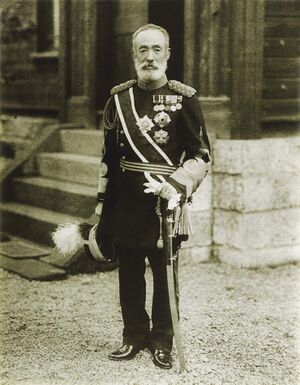
At the outbreak of the war, the Stoinian Corinian Defence Fleet was largely ordered to maintain a defensive position in Corinia while troops could be mobilised overseas following the demobilisation of Ezervulge. On October 17th however, Corinia would see its first conflict, ending the one month of waiting. The Imperialist fleet lead by Karnetvorian Admiral Vojkan Karanović consisted of roughly 42 and 31 Karnetvorian and Techanarean ships respectively. The joint task force was meant to cripple the Corinian Defence Fleet in a swift stroke. It would come face-to-face with multiple contingents of 65 ships of the Corinian Defence Fleet patrolling near the island of Taiping that belong to Stoinia. What ensued of the Battle of Taiping was a major Stoinian defeat as the sparse patrol detachment were picketted one by one and swiftly outgunned by the Imperialist fleet. Mainly Stoinian screen ships were sunk, but ship losses included 10 cruisers, the battlecruisers HMS Milescu and HMS Reghea, and the battleship HMS Cetus. In total, the Stoinians had lost 52 ships with the Imperialists only lost 13 ships.
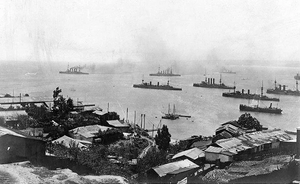
Following the Battle of Taiping, the Imperialist fleet believed it had destroyed the Corinian fleet and Admiral Vojkan Karanović in his pride decided to instil terror on Shai Kong before docking in its ports. As such, the Imperialist fleet came near the shore of Shai Kong earlier than what normal protocol would dictate. This would prove to be a mistake by the Imperialist fleet as the Shaikongers alerted the surviving elements of the Corinian Defence Fleet stationed in Carao. The most senior officer was Commodore Ryuk Dae-Jung. Scrambling the remaining 29 docked ships in Carao, Commodore Dae-Jung set out to defend Corinia from the Imperialists. As the First Naval Battle of Shai Kong started, Commodore Dae-Jung had the ageing dreadnought HMS Fujani position itself perpendicular to the coast and serve as the main battering ram while another squadron of screen ships would flank them from the sea, locking the Imperialist fleet from three sides. However, what truly tipped the scale of the battle was his use of aircraft carriers. HMS Takao, his own carrier was accompanied by two more light carriers HMS Veleta and HMS Vacares. As the aeroplanes were deployed out of reach from the Imperialist fleet, they dealt critical blows paired with the barrages from the rest of the Corinian fleet. The First Naval Battle of Shai Kong would become one of the first battles in which modern aircraft carriers proved their merit as a modern doctrine to pursue. Commodore Dae-Jung would lose only 3 destroyers while the Imperialist fleet of remaining 59 ships was completely sunk. Admiral Karanović would not survive the battle and fail to inform the Imperialist forces of the tactics used by Commodore Dae-Jung.
In the following months, Commodore Dae-Jung fought off multiple attempts by Imperialist forces to conquer Shai Kong and Corinia, totalling 15 military engagements from October 1949 to June 1950. The defeat of the Imperialist forces was in large part due to the inadaptability of the Imperialist naval officers when faced with Commodore Dae-Jung's use of aeroplanes against which they were mostly ill-equipped. Nonetheless, the Corinian Defence Fleet valiantly continued to defend the Stoinian territory on Cordilia. Commodore Dae-Jung would be hailed a national hero for his achievements and be given the highest order of Stoinian military decorations. In addition, he was named the Lord Admiral of Corinia by King Mihai III, becoming the first Paeo-Garanian to receive the honour, gaining him much renown with the Shaikongers. His authority as Lord Admiral would also include the ships that would come to reinforce Corinia later on. However, Lord Admiral Dae-Jung would not rest his fate to stalled reinforcements and in accordance with the Governor of Shai Kong Aleroma Beverino, would start converting transport vessels into light aircraft carriers to bolster the Defence of Corinia while awaiting for the larger Stoinian naval reinforcements after the Second Naval Battle of the Brevero Sea.
Operation Nighthawk - Operation Nochna Pnista (1949)
The Techanarean Imperial Navy would however be able to swiftly conquer the port cities of Sulina, Vudesque and Lonfar in Actora from Stoinia under the command of Admiral Hakin Myaunalki who sieged the cities on October 28th. Although the Stoinian fleets were easily outgunned and sunk, the local populace continued to fight the occupation. However, the occupation under Admiral Hakin Myaunalki would prove a reign of terror which would be cemented in the conscience of the port cities which would eventually lead to the handover of the cities in 1975. The port cities would however be liberated by the Lord Admiral Dae-Jung in August 1952 following the consolidation of the Stoinian Royal Navy in the Sub-Capricorn territories on Cordilia and Crabry.
Supra-Capricorn Theatre (1949-1951)
Preliminary Imperialist offensives in the Central Islands (1949-50)

Stoinia was in a precarious position as it now was at war with Karnetvor, Techganet, Ubesii, Father States and the Gianlucian Empire. Although allied with Sedunn, Termina and Ryccia the Stoinain Royal Navy despite its size was forced to spread over multiple fronts in the Mediterranean, Sub-Capricorn and Supra-Capricorn. Nevertheless, Prime Minister Stegăroiu vowed to protect the Stoinian territories of Carraca, Pētea and the Lile Uile Islands as well as guaranteeing the independence of Conaro. It would see the first Imperialist attempt to conquer the strategic Central Islands under Admiral Radomir Zorić who was an old friend of Fleet Admiral Alonso Barreto, the Commander of the Pacific Fleet. A large fleet, 122 strong, set sail from Tasternine and arrived in the Brevero Sea on October 15th 1949. There it clashed with the Stoinian Royal Navy under Fleet Admiral Alonso Barreto's Pacific Fleet in the First Naval Battle of the Brevero Sea. The battle was a pyrrhic Stoinian victory with many losses on both sides with 65 and 72 Allied and Imperialist ships sunk. One of the sunken ships was the HMS Proteus, a prominent battleship of the Stoinian Royal Navy and considered by some as the pride of the battleships. The First Battle of the Brevero Sea would prove the first strike in a one-two punch. However, with the Mediterranean Sea being threatened by Tekarai, Stoinia committed a large portion of its navy to help Sedunn to neutralise the Tekarian naval threat, leaving the Central Islands largely undermanned for subsequent offensives.
In December 1949, continued raids and harassment campaigns by the Karnetvorian Imperial Navy, the Stoinian Royal Navy had been severely depleted of its strength. Sedunn's and Stoinia's navies were strained from the previous battles and patrolling. Both nations needed time to recover and reinforce their spread-out navies. Additional ships were ordered on a massive scale in both Sedunn and Stoinia. Despite this, naval warfare was remarked to have been relatively tame compared to other naval battles due to the brotherly bond between the two naval commanders, often saving enemy sailors from drowning. This was a rare participation of a Stoinian officer joining in the Gentlemen's War as both Admiral Radomir Zorić and Fleet Admiral Alonso Barreto had forged a bond in a military training exercise prior to Karnetvorian imperialism between Karnetvor, Sedunn and Stoinia. Fleet Admiral Alonso Barreto would, however, prove to be an exception to this rule as most Stoinian officers preferred to incorporate Bellica Incessante tactics which emphasised creating as many military casualties as possible.
Imperialist invasion of the Central Islands (1949-1950)
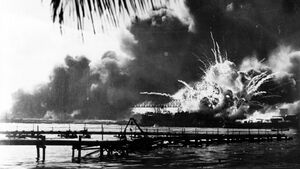
In January 1950, the Karnetvor invaded and annexed Government Island. The entirety of the population was deported. The island had great strategic value and was to be used as a stepping stone for the planned invasion of the Siculites and other central islands later.
As the situation stabilised in Termina by February 1950, Karnetvor still wasn't in full control yet as the capital was not in their hands yet. Following its surprise attack on Kanaka Harbour in the Lile Uile Islands on January 14th, the Imperialist forces of Karnetvor, Techganet and Tekarai under the command of Admiral Radomir Zorić engaged Fleet Admiral Alonso Barreto in the Second Naval Battle of the Brevero Sea. This time the Imperialist forces had gained the upper hand and landed on the Siculite Islands as well as Pētea and the Lile Uile Islands. Not even the native stronghold of the Garāori in the Carracan archipelago, Matakana Island, was spared. In a month, they defeated the Ryccian defenders, but the Ryccians and the natives fought a guerrilla campaign, that was not fully defeated until April. Similarly, the Stoinians and native islanders held valiant defences for a couple of months but were outnumbered in the end before resorting to sleeper cells. Karnetvor officially annexed the islands, but the Second Naval Battle of the Brevero Sea had seen no decisive victor in the Central Islands and a stalemate on the Carracan main island followed. However, the Principate of Conaro decided to join the war effort through the Conegasque Expeditionary Corps as Stoinian officers had trained troops since the beginning of the war. Although only adding roughly 20,000 troops to the larger war effort, the Conegasque Expeditionary Corps consisted of roughly 5% of the Conegasque population and would become one of the most lethal military units throughout the war.
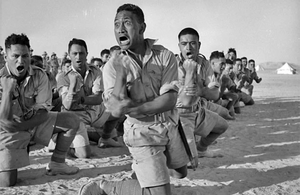
Seeing their ancestral islands being occupied and their peoples abused instilled a fire within the Garāori, Islander and Pētean Army Corps' soldiers who mostly comprised of the natives of the Central Islands. Under Lieutenant-General Paul Celăreanu, GIPAC forces would cross the Raukawa Strait between Kihei and the Carracan island on the dawn of May 5th 1950. This signalled fellow Gipac sleeper cells who remained undercover on other islands to attack as well. The Imperialist forces had no knowledge of these prior sleeper cells as they hid most of their equipment in dense forests and attacked by night. This lightning attack by the Gipacs instilled terror within the stationed Imperialist forces as the Gipacs engaged zealously in surgical precise guerilla warfare utilising the knowledge of their native lands. Within two days, Kihei was liberated and the Gipacs performed a legendary haka dance which was seen by distant Imperialist naval forces who chose not to reclaim the city after seeing the dance. This would bring in a response from the Imperialist forces which Allied forces exploited in the Third Naval Battle of the Brevero Sea on May 15th. Fleet Admiral Alonso Barreto lead the Allied Pacific Naval Task Force and after conferring with Lord Admiral Dae-Jung, he heavily utilised the newly built Stoinian aircraft carriers to exploit the weaknesses of the Imperialist navies. This proved to be the decisive doctrine that lead to the defeat of the Imperialist forces commanded by Admiral Radomir Zorić. Admiral Radomir Zorić, having been decisively defeated, raised his white flag and surrendered to Allied forces. Recognising the ship, Fleet Admiral Alonso Barreto set course to board the vessel and upon docking with the battleship of Admiral Radomir Zorić, HMS Corisia, said the following:
"My old friend, you have bested me. I yield now in honour of our old friendship which hasn't corroded throughout our battles. Before you bring me to your tribunals, I must commend your troops. In particular these Gipacs of yours. I have seen from afar what these brave men have done alongside tales which left my men quivering. Truly marvellous warriors who we've had the misfortune to be on opposing sides with. If I want to keep an island I'd ask Admiral Dae-Jung, but if I want to conquer an island, I'd beg for the Gipacs. Their bravery has proven the error of my government's policies which have never sat right with my conscience. Such bravery shouldn't be caged. You have beaten me both tactically and morally. A sweeter victory I could not wish upon my enemy nor my old friend."—Admiral Radomir Zorić upon surrendering to Fleet Admiral Alonso Barreto after the Third Naval Battle of the Brevero Sea.
In the following months, the GIPAC forces spearheaded the liberation of Government Island, Pētea and the Lile Uile Islands, gaining much renown and admiration from both Allied and Imperialist forces. Similarly, the Conegasque Expeditionary Corps achieved reputable achievements to a lesser extent as well in this campaign, though Imperialist forces were known to surrender upon sighting GIPAC forces. These battles established the Garāori, Islander and Pētean Army Corps as one of Stoinia's most elite military units. Despite liberation efforts, the Imperialist forces on the Sicullite islands remained heavily fortified and isolated. Instead of risking high casualties, Allied forces decided to weed out the Siculites over a longer period of time by demoralising the Imperialist forces. Making it a unique stronghold within the Central islands throughout the war. This campaign would continue until the liberation in May 1953 by Ryccian and Sedunnic forces. The Karnetvorian lead Imperialist forces would however dare sporadic efforts to pierce through the Allied blockade of the northern Central Islands to resupply the Siculites. However, the Imperialist encryption coding system called Zagadka (Karnetvorian: загадка), would be decrypted by the Litanian mathematician, computer scientist and cryptanalyst Abilio Torrado which prevented any more successful Imperialist advancements into the Central Islands. Typically by intercepting the messages and deploying Stoinian aeroplanes from its aircraft carriers to sink Karnetvorian warships without necessarily revealing they cracked the Zagadka Code.
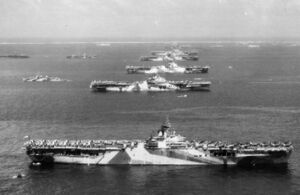
As the Stoinian Royal Navy recuperated from the Third Naval Battle of the Brevero Sea, Fleet Admiral Alonso Barreto was promoted to Lord Admiral of the Pacific and unified multiple national fleets, including the remnants of the Cadisian Navy, under one command. Bolstered by the numerous offensives in the Central Islands, the Ikaranarean Father States deployed the Narussian Navy to conquer the strategic islands after the Karnetvor-lead forces had failed to do so. In addition, Ikaranarean leadership was eager to prove its naval dominance following the Stoino-Ikaranarean naval arms race. With modern warships and a new doctrine, the Narussian Navy engaged the Stoinian Royal Navy on June 16th in the Fourth Battle of the Brevero Sea.
One of the first battles which saw aircraft carriers fight against each other.
Operation Sovereign - Stoinian invasion of the Father States (1951-1952)
Landed in Cadíz September 24th 1951. Conegasque Expeditionary Corps General Iuliu Măcărescu
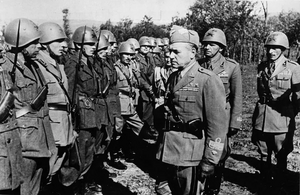
Central Bailtemmic front (1949-1951)
<--Sallodesian annexation of Neu Katzberg & Neu Faburg, Fauderland puppet Detroxia -> Sallodesian front with Detroxian & Regan resistance help-->
Stagnation and rise of rebellions (1951-1952)
The frontlines in Termina were stable in 1951 thanks to both sides being able to send reinforcements. Imperialist air forces launched an unsuccessful bombing campaign on the Sedunnic west coast from Government Island and the Carraca. On March 5 1952 the Sedunnic King Hevv died and Queen Yemms Sperallu replaced him. It is not known if the cause was natural.
Sedunn and Ryccia launched a top-secret plan to develop nuclear weapons.
Rebellion in Ubesii
By June, it was becoming evident that Tekarai was struggling to maintain order in Ubesii and a new law was passed, which deprived Ubesians of their citizenship and forced many of them to live in closed-off ghettos. This sparked an armed rebellion, which slowly gained momentum.
Rebellion in Huawan
During the first two years of the war, the Peocracy had been strictly neutral. Then through the agitation of Mikhail Aerinn, the country started questioning the role of The Peony and its decisions, plunging the country into a civil war in August 1951. Three sides rose: one faction supported the Imperialists, being sympathetic towards the Karnetvorians avenging the crown prince and harbouring anti-Sedunnic sentiments, one that supported the Allies, and one that supported the status quo (which was the stance of the Royal Palace).
In July 1952 the civil war in Huawan was resolved with the infiltration of the shogunates of Huawan, and the Peony regained complete control. Evidence of Sedunnic agitation, and private calls for alliance with the Imperialists were uncovered. But The Peony maintained the court, and assured that "no further blood was to be spilled", and that she would not join the war.
Rebellion in Arnchow
Operation Trinitas (1951-1952)
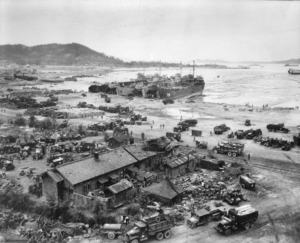
Despite global tendencies, the Supra-Capricorn saw a major development with a Stoinian amphibious campaign in the heart of the Ikaranarean states through Operation Trinitas. General Iuliu Măcărescu
Invasion of Huawan and entry of Izaakia (1952)

Fearing that the Peonic Navy could still enter the war on the Allies' side, the Imperialists took pre-emptive action to ensure that the ships would not enter the ocean. After a rejected ultimatum to join the Imperialist side, Imperialist forces landed on Hai Men Island in August 1952 and airborne troops landed in the Shogunate of Minnan that was trying to secede from Huawan, taking advantage of the Stoinian naval campaign to liberate the conquered port cities east of Crabry. By controlling the island of Hai Men, the goal was to close the straits between the island and Huawan Seaside and block vessels from leaving Huawan. The Imperialists rapidly gained ground, but never completely controlled the island due to the fierce guerilla fighting and support from the Izaakian garrison in Hai Men City. However, the Imperialists established control over the straits for a time and managed to damage some of the Peonic ships at dock.
Izaakia declared war on Karnetvor and invaded the Karnetvorian Antarctic to reclaim territories lost in 1883-1885 and 1915. In October 1952 Izaakia had initial successes against the Karnetvorians in Keyli, liberating Manta City, but their advance was halted by Techganet reinforcements.
Allies gain momentum (1953–1954)
In August 1953, Imperialist forces finally laid siege to the TCC capital, having pushed a costly advance for almost six months. The battle was brutal, as it quickly degenerated into house to house fighting. In October, the Imperialists had taken half of the city, but could not replace their losses as easily as the Allies. On December 3, the Allies counterattacked, destroying the Imperialist divisions that defended the outskirts of the city. The Allies then surrounded the Karnetvorian forces. The situation became dire, as they were left without food, water, or ammunition, and supplying the besieged Karnetvorians became impossible. They were annihilated. The Battle of Clocktown, the most bloody battle of the war, ended on February 4th, 1954, when the remaining Karnetvorians surrendered to the Allies and the devastated city was liberated. The Imperialist survivors were captured and sent to POW camps. They only returned home after the end of the war. The battle proved to be the turning point of the war, the Imperialists could never resupply their forces properly. Remaining Imperialist forces started retreating towards Tasternine, fighting a successful delay campaign against the Allied forces, implementing a scorched earth policy; the Imperialist soldiers burned villages, destroyed railways and roads, killed civilians, and looted or destroyed anything that could help the enemy. In Karnetvor, Prime Minister Masić was given emergency powers, allowing him to take decisions without parliamentary oversight. In Tekarai, the government started the "Final Solution" to the "Ubesiian problem", deporting Ubesians to concentration camps, and killing them by shootings or gas.
As the battle for Clocktown dragged on, the Allies ramped up their naval campaigns. During the Battle of the Tasterninian Sea, July 19 1953, the Sedunnic, Ryccian, and Stoinian navies destroyed Karnetvor's Tasterninian Fleet, cutting off the Imperialists in Termina from Tasternine. The Allies landed in Tasternine, which fell a month later, on August 25th. Tasternine was the first core Imperialist territory to be captured by Allied forces.
In August, combined Peonic-Izaakian forces were also successful against the Imperialists. The Imperialist forces on Hai Men Island surrendered after a series of battles. Meanwhile in southern Huawan, the Imperialists were defeated in the largest battle of the war in southern Cordilia. The Peonic Navy could finally leave its ports. Huawan officially joined the war on the Allies' side.
On December 14 1953, Allied forces landed on the Siculite Islands, liberating them almost without resistance, as the demoralised Karnetvorians had run out of supplies due to the fall of Tasternine. The Karnetvorians surrendered three days after the landings. The same month, Ubesii declared its independence from Tekarai following the advance of the rebels. <--In January 1954 the Karnetvorian forces on Piel Island surrendered without a fight, being totally cut off and outgunned.-->
Allies close in (1954)
On February 10, 1954, the new Republic of Ubesii had defeated the Tekaraian Army and stopped the Ubesiian Genocide. Tekarai, faced by a possible Allied invasion, informed the Allies of their decision to surrender. Karnetvorian Prime Minister Masić took the news as a betrayal, and severed relations with Tekarai. Ubesii, now enjoying international recognition, declared war against Karnetvor. Ubesii sent its own units to fight with the Allies.
Imperialists in occupied territory were low on supplies and morale, which the Allies took advantage of. Government Island was liberated by the Allies in March. Large-scale bombing campaigns of Mainland Karnetvor were initiated, targeting the industry and naval and air bases. On May 13th, the surviving Imperialists in Termina surrendered. In September 1954, Allied naval forces defeated a joint Imperialist navy in the Battle of Foreseas. The joint navy was the last time the Imperialists managed to deploy a larger naval force. Protests and strikes against the government happened in Karnetvor.
Collapse of the Imperialists (1954-1955)
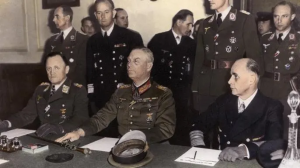
As conditions had worsened for the Techanerean economy and due to a lack of battlefield success and the loss of most of its naval forces, Techganet decided to negotiate a separate peace with the Allies on new years eve, 31 December 1954. All territories gained in Crabry were ceded to the Allies, and the Techanerean king was required to broadcast a formal apology for Techganet's involvement in the war. This significantly weakened Karnetvor's ability to defend its home waters and the Allies gained total supremacy at sea.
Due to the timely surrender of Techganet, the Allies were confident enough to land troops on Mainland Karnetvor on February 1, significantly bolstered by Peonic land and air forces. The invasion shocked the Karnetvoiran government as well as the population. Prime Minister Masić tried to convince the Karnetvorian people to fight to the death for their country, but they had had enough. Behind the scenes, General Dragov, King Peter II, and the opposition had started plotting to overthrow Masić and end the war. In an emergency session on February 5, the Parliament adopted a motion of no confidence in Masić's government, with most members of his own party voting in favour. Masić contacted the army to evaluate his options, but Dragov had convinced the Armed Forces to remove Masić by force if the plan failed. King Peter officially deposed Masić on February 6th, and ordered his arrest on charges of abuse of power, violating the Constitution, and war crimes, which was carried out the same day. Dragov was appointed Interim Prime Minister by the King. Due to his earlier support for both the war and Masić's government, the King's position became untenable, and, to avoid a general uprising, he abdicated in favour of his daughter, Princess Zelda. The next day, February 7, 1955, Karnetvor surrendered to the Allies, ending the war. The Arnchow Rebellion would continue to drag on violently for another year after the capitulation of Karnetvor until the weakened Republic of Arnchow capitulated to the Allies through the signing of the Treaty of Jalan Mulut Timur on July 11, 1956 during the Siege of Hsi'an.
Aftermath
More than xx million people died on the war. It is the deadliest war in South Pacifican history.
Karnetvor was under Allied occupation for ten years. Karnetvor was declared to be the main perpetrator of the war. As such, it lost all of its colonies (Karnetvorian West Keylian Territories to Izaakia, Marresa to Ryccia), with the exception of Tasternine; half of the Tasterninian population was (and still is) of Karnetian (Karnetvorian native) descent. Karnetvor also renounced all claims on Termina, and lost its status as a major power. Princess Zelda was officially crowned Queen on January 1st, 1956, and elections were held two weeks later, resulting in an Opposition victory. The Imperialists were also forced to pay war reparations to the Allies, which were completed in the 1970s. In 1989, after the fall of the monarchy, the new republican government in Karnetvor announced it would not respond to any more reparations claims, due to the debt being already paid.
In Sedunn the policy of combatting expansionism in the South Pacific was questioned, and in the 1960 elections the Moderate Party promised to pursue a less "extraverted" foreign policy and refrain from policing abroad and to reduce military expenses. However, with its infrastructure and industry largely intact, the Sedunnic economy entered the post-war era in a strong position.
To this day, the war is a controversial topic in Karnetvor, and Prime Minister Masić (who was released in 1969, dying three years later) is a controversial figure, with some praising him for defending the country's interests, and others condemning him for bringing it to ruin.
However, the war also resulted in limited decolonisation of Stoinia mainly through the efforts of the Garāori, Islander and Pētean Army Corps. King Mihai III was so impressed by the performance of the Gipacs that He granted the local authorities to hold referenda and consult the will of the natives. The Islanders voted in favour of independence while the Peteans voted to become independent but wished to live under the Stoinian King. Remarkably, the Garāori chose to remain within Stoinia as many believed they had become Stoinian over the course of the war. Nonetheless, the Gipac legacy continues to this day through the Commonwealth of Realms and the harbouring of overseas Stoinian Royal Naval bases. One particular naval base is Kanaka Harbour which became a joint Stoino-Sallodesian naval base as both countries vowed to protect the Lile Uile Islands, establishing Sallodesia as a growing naval power in the South Pacific.